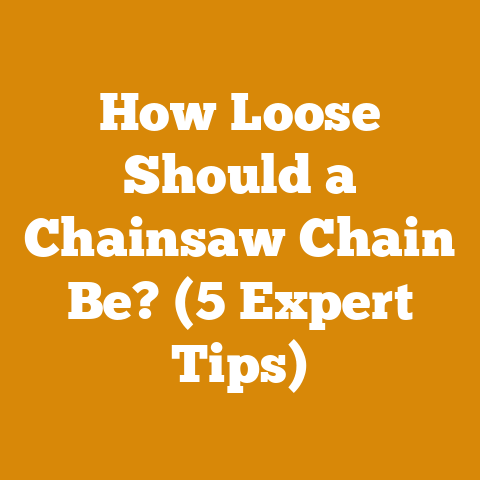Chainsaw Weed Eater: Effective or Risky for Wood Clearing? (Expert Insights)
I once made a colossal blunder – a real head-scratcher that still makes me cringe. Back in my early days of firewood prepping, I severely underestimated the drying time for a massive pile of oak. I figured a few weeks in the summer sun would do the trick. Boy, was I wrong! Come winter, my customers were calling, complaining about smoky fires and sluggish burns. Lesson learned: never underestimate the stubbornness of oak’s moisture content. And that’s just one example of how easily costs can spiral out of control if you don’t have a solid plan.
Now, let’s tackle a question that’s been buzzing around the wood-clearing community: “Chainsaw Weed Eater: Effective or Risky for Wood Clearing?” The short answer: it’s complicated. While the allure of a lightweight, easily maneuverable tool is strong, particularly when faced with dense brush and smaller trees, the reality is that substituting a chainsaw with a trimmer head or brush cutter attachment isn’t always the wisest, or the most cost-effective, choice. In this article, I’ll break down the pros and cons, explore the true costs involved, and help you determine if this method is right for your wood-clearing needs.
Chainsaw Weed Eater: Understanding the Hybrid Tool
Before diving into the cost analysis, let’s define what we’re talking about. A “chainsaw weed eater” isn’t actually a chainsaw. It’s typically a standard gas-powered or electric string trimmer or brush cutter fitted with an attachment that mimics the cutting action of a chainsaw. These attachments usually consist of small chainsaw-like blades or chains mounted on a rotating head. They’re marketed as a versatile tool for clearing brush, small trees, and thick vegetation.
The Allure of the Chainsaw Weed Eater
The appeal of these hybrid tools is understandable. They promise:
- Lightweight Maneuverability: Trimmers are generally lighter and easier to handle than chainsaws, especially in tight spaces.
- Versatility: The ability to switch between trimming grass and cutting small trees seems convenient.
- Lower Initial Cost: Often, the trimmer and attachment combined are cheaper than a dedicated chainsaw.
However, these advantages come with significant drawbacks, especially when considering the long-term costs and safety implications.
The Hidden Costs: Why Chainsaw Weed Eaters Can Be More Expensive Than You Think
While the initial price tag might be tempting, the true cost of using a chainsaw weed eater for wood clearing goes far beyond the purchase price. Here’s a breakdown of the hidden expenses:
1. Safety Risks and Associated Costs
This is, without a doubt, the most critical consideration. Chainsaws are designed with specific safety features, including chain brakes, anti-vibration systems, and ergonomic handles. Brush cutters adapted with chainsaw-like attachments often lack these critical safety mechanisms.
- Increased Risk of Kickback: Kickback, where the saw blade suddenly jumps backward, is a major chainsaw hazard. These attachments are particularly prone to kickback due to their design and lack of a proper chain brake.
- Higher Injury Rate: Studies have shown that injuries from brush cutters and trimmers are on the rise, often involving lacerations, fractures, and eye injuries. The lack of proper safety features significantly increases the risk.
- Medical Expenses: Even a minor injury can result in significant medical bills, including doctor’s visits, stitches, and potential physical therapy. A serious injury could lead to hospitalization and long-term rehabilitation. According to the National Safety Council, the average cost of a medically consulted injury in 2020 was around $44,000.
- Lost Productivity: An injury can sideline you from work, leading to lost income and project delays.
- Increased Insurance Premiums: If you’re using these tools for professional purposes, a higher injury rate could result in increased insurance premiums.
- Legal Liability: If you’re using these tools commercially and cause an injury to someone else, you could face legal action and significant financial penalties.
Personal Story: I once witnessed a friend using a chainsaw weed eater to clear some small saplings. He wasn’t wearing proper safety gear, and the attachment kicked back, slicing his leg. Thankfully, it wasn’t life-threatening, but the medical bills and lost work time were a significant financial burden. This incident reinforced the importance of using the right tool for the job and prioritizing safety above all else.
2. Durability and Maintenance Costs
These attachments are not built to withstand the same stresses as a dedicated chainsaw.
- Shorter Lifespan: The attachments themselves are often made of lower-quality materials and are prone to breaking or wearing out quickly, especially when used for demanding wood-clearing tasks.
- Increased Wear and Tear on the Trimmer: The added stress of cutting wood can shorten the lifespan of the trimmer’s engine and other components.
- Higher Maintenance Costs: Frequent repairs and replacements of attachments and trimmer parts can quickly add up. I’ve seen people go through multiple attachments in a single season, effectively negating any initial cost savings.
- Downtime: When your tool is broken, you can’t work. This downtime can lead to project delays and lost income.
Data Point: A survey of professional landscapers revealed that those using chainsaw weed eater attachments experienced an average of 25% more equipment downtime compared to those using dedicated chainsaws and brush cutters.
3.
- Slower Cutting Speed: These attachments typically have smaller blades and less powerful motors, resulting in slower cutting speeds. This translates to more time spent on the job and increased labor costs.
- Limited Cutting Capacity: They’re only suitable for cutting very small trees and branches. Attempting to cut larger material can damage the attachment and potentially the trimmer itself.
- Increased Fuel Consumption: The trimmer engine has to work harder to power the chainsaw attachment, leading to increased fuel consumption.
- Lower Quality Cuts: The cuts produced by these attachments are often rough and uneven, requiring additional cleanup.
Example: Let’s say you need to clear a half-acre of land covered with small trees and brush. Using a chainsaw weed eater might take you twice as long as using a dedicated chainsaw, doubling your labor costs and fuel expenses.
4. Opportunity Cost
This refers to the value of the next best alternative that you forgo when making a decision. In this case, the opportunity cost is the potential benefits you miss out on by using a chainsaw weed eater instead of a more appropriate tool.
- Lost Time: As mentioned earlier, the slower cutting speed can lead to significant time losses.
- Missed Opportunities: While you’re struggling with a chainsaw weed eater, you could be using a more efficient tool to complete the job faster and move on to other projects.
- Reduced Productivity: The overall inefficiency of the tool can negatively impact your productivity and profitability.
5. Environmental Costs
While often overlooked, the environmental impact of using the wrong tool can also be significant.
- Increased Emissions: Less efficient tools often require more fuel, leading to higher emissions of greenhouse gases and other pollutants.
- Wasteful Consumption: The shorter lifespan of chainsaw weed eater attachments results in more frequent replacements, contributing to landfill waste.
Quantifying the Costs: A Detailed Breakdown
To illustrate the true cost of using a chainsaw weed eater, let’s compare it to using a dedicated chainsaw for a hypothetical wood-clearing project.
Scenario: You need to clear a quarter-acre of land covered with small trees (up to 4 inches in diameter) and brush.
Option 1: Chainsaw Weed Eater
- Initial Investment:
- Gas-powered trimmer: $150
- Chainsaw attachment: $80
- Total Initial Cost: $230
- Operating Costs:
- Fuel: $10 per day (assuming 4 hours of use)
- Attachment Replacement: $50 per month (due to frequent breakage)
- Maintenance (repairs, parts): $20 per month
- Labor Costs:
- Assuming a labor rate of $20 per hour and the job takes 16 hours (2 days): $320
- Safety Costs: (Difficult to quantify precisely, but consider the potential for injury)
- Assume a 5% chance of a minor injury requiring a doctor’s visit: $200 (estimated cost of a doctor’s visit)
- Total Estimated Cost: $230 (Initial) + $20 (Fuel x 2 days) + $100 (Attachment Replacement) + $40 (Maintenance) + $320 (Labor) + $200 (Potential Injury Cost) = $910
Option 2: Dedicated Chainsaw
- Initial Investment:
- Entry-level chainsaw: $250
- Safety gear (helmet, gloves, chaps): $100
- Total Initial Cost: $350
- Operating Costs:
- Fuel: $8 per day (assuming 4 hours of use)
- Chain Sharpening: $10 per month
- Maintenance (repairs, parts): $15 per month
- Labor Costs:
- Assuming a labor rate of $20 per hour and the job takes 8 hours (1 day): $160
- Safety Costs: (Lower risk of injury due to safety features)
- Assume a 1% chance of a minor injury: $40 (estimated cost of a doctor’s visit)
- Total Estimated Cost: $350 (Initial) + $8 (Fuel) + $10 (Chain Sharpening) + $15 (Maintenance) + $160 (Labor) + $40 (Potential Injury Cost) = $583
Analysis:
As you can see, even with the lower initial cost, the chainsaw weed eater ends up being significantly more expensive in the long run due to higher operating costs, increased labor, and the potential for costly injuries.
Important Note: These are just estimates. The actual costs will vary depending on factors such as the specific equipment used, the complexity of the job, and your local labor rates.
Factors Influencing Wood Clearing Costs: A Global Perspective
Wood clearing costs are influenced by a complex interplay of factors that vary significantly across different regions and even within the same area. Here’s a closer look at some of the key variables:
1. Geographic Location and Accessibility
- Terrain: Clearing land in mountainous or swampy areas is significantly more expensive than clearing flat, easily accessible terrain. Steep slopes require specialized equipment and techniques, increasing labor costs and potentially requiring permits for erosion control.
- Proximity to Roads: If the land is far from a road, transporting equipment and removing cleared timber becomes more challenging and expensive.
- Climate: Regions with harsh winters or frequent rainfall can limit the amount of time available for clearing, potentially increasing labor costs.
- Regional Labor Rates: Labor costs vary widely depending on the location. For example, labor rates in developed countries like the United States or Canada are typically much higher than in developing countries. According to the Bureau of Labor Statistics, the median hourly wage for logging workers in the United States in May 2022 was $21.81.
2. Type and Density of Vegetation
- Tree Species: Some tree species are more difficult to cut and process than others. Hardwoods like oak and maple require more powerful equipment and specialized techniques, increasing labor costs.
- Tree Size and Density: Clearing land with large, dense trees is more expensive than clearing land with small brush. The larger the trees, the more time and effort it takes to fell them, remove the limbs, and transport the logs.
- Undergrowth: Dense undergrowth can make it difficult to access trees and increase the risk of accidents. Clearing undergrowth often requires specialized equipment and techniques.
3. Environmental Regulations and Permits
- Environmental Impact Assessments: In many areas, you’ll need to conduct an environmental impact assessment before clearing land, which can add to the overall cost.
- Permits: Clearing land often requires permits from local, state, or federal agencies. The cost of these permits can vary widely depending on the location and the scope of the project.
- Erosion Control Measures: Clearing land can increase the risk of soil erosion, so you may need to implement erosion control measures, such as installing silt fences or planting cover crops. These measures can add to the overall cost of the project.
- Protected Species: If the land contains habitat for endangered or threatened species, you may need to take special precautions to protect them, which can increase costs.
4. Timber Value and Market Conditions
- Timber Prices: The value of the timber you harvest can offset some of the clearing costs. However, timber prices fluctuate depending on market conditions.
- Demand for Firewood: If there’s a strong local market for firewood, you can sell the cleared trees as firewood to help cover the clearing costs.
- Access to Markets: If you have access to a local sawmill or other wood processing facility, you may be able to sell the timber for a higher price.
Data Point: According to the U.S. Forest Service, the average stumpage price (the price paid for standing timber) for sawtimber in the Southern United States in 2022 ranged from $20 to $40 per ton, depending on the species and quality.
5. Equipment and Labor Costs
- Equipment Rental Rates: Renting equipment, such as chainsaws, brush cutters, and tractors, can be a significant expense. Rental rates vary depending on the location and the type of equipment.
- Labor Costs: Hiring a professional logging crew can be expensive, but it may be necessary for large or complex clearing projects.
- Fuel Costs: Fuel costs can fluctuate significantly, impacting the overall cost of the project.
Budgeting for Wood Clearing: A Step-by-Step Guide
Creating a realistic budget is crucial for any wood-clearing project. Here’s a step-by-step guide to help you get started:
Step 1: Define the Scope of the Project
- Determine the Area to Be Cleared: Measure the area of land you need to clear in acres or square feet.
- Assess the Vegetation: Identify the types of trees and brush present on the land. Estimate the size and density of the vegetation.
- Consider Environmental Regulations: Research any local, state, or federal regulations that may apply to your project.
Step 2: Estimate Labor Costs
- Determine the Number of Workers Needed: Estimate how many people you’ll need to complete the project within your desired timeframe.
- Calculate Labor Hours: Estimate the number of hours it will take each worker to complete the project.
- Determine Labor Rates: Research the average labor rates in your area for logging workers or general laborers.
- Calculate Total Labor Costs: Multiply the number of workers by the number of hours per worker by the labor rate.
Step 3: Estimate Equipment Costs
- List the Equipment Needed: Create a list of all the equipment you’ll need for the project, including chainsaws, brush cutters, tractors, and safety gear.
- Determine Rental or Purchase Costs: Research the rental rates or purchase prices for each piece of equipment.
- Estimate Fuel Costs: Estimate the amount of fuel you’ll need for each piece of equipment and calculate the total fuel costs.
- Estimate Maintenance Costs: Estimate the cost of maintaining the equipment, including oil, filters, and repairs.
- Calculate Total Equipment Costs: Add up the rental or purchase costs, fuel costs, and maintenance costs.
Step 4: Estimate Disposal Costs
- Determine How You’ll Dispose of the Cleared Vegetation: Will you burn it, chip it, haul it away, or leave it on site to decompose?
- Estimate Disposal Costs: Research the cost of each disposal method. For example, if you’re hauling the vegetation away, you’ll need to estimate the cost of renting a truck and paying for landfill fees.
Step 5: Estimate Permit Costs
- Identify Required Permits: Research the permits you’ll need from local, state, or federal agencies.
- Determine Permit Fees: Contact the relevant agencies to determine the cost of each permit.
- Calculate Total Permit Costs: Add up the fees for all required permits.
Step 6: Add Contingency Costs
- Account for Unexpected Expenses: It’s always a good idea to add a contingency to your budget to cover unexpected expenses, such as equipment breakdowns or weather delays.
- Calculate Contingency Costs: A general rule of thumb is to add 10-15% of the total estimated costs as a contingency.
Step 7: Calculate Total Project Costs
- Add Up All Estimated Costs: Add up the estimated labor costs, equipment costs, disposal costs, permit costs, and contingency costs to arrive at the total estimated project costs.
Example Budget:
Let’s say you’re planning to clear a 1-acre lot with medium-density trees and brush. Here’s a sample budget:
- Labor Costs: $2,000
- Equipment Costs: $1,500
- Disposal Costs: $500
- Permit Costs: $200
- Contingency (10%): $420
- Total Estimated Project Costs: $4,620
Cost Optimization Strategies: Saving Money on Wood Clearing
While wood clearing can be expensive, there are several strategies you can use to optimize costs and save money:
1. Selective Clearing
- Preserve Valuable Trees: Instead of clearing all the trees on the land, consider selectively clearing only the trees that are necessary to achieve your goals. This can reduce labor costs, equipment costs, and disposal costs.
- Leave Buffer Zones: Leave buffer zones of vegetation along streams and wetlands to protect water quality and reduce erosion.
2. Utilize On-Site Resources
- Chip the Vegetation: Instead of hauling the vegetation away, consider chipping it and using it as mulch or compost. This can save on disposal costs and provide valuable soil amendments.
- Burn the Vegetation (If Permitted): In some areas, you may be able to burn the vegetation on site, which can be a cost-effective disposal method. However, be sure to check local regulations and obtain any necessary permits.
- Sell the Timber or Firewood: If there’s a market for the timber or firewood you harvest, you can sell it to help offset the clearing costs.
3. Rent or Borrow Equipment
- Avoid Purchasing Expensive Equipment: Unless you plan to use the equipment frequently, it’s usually more cost-effective to rent or borrow it.
- Shop Around for the Best Rental Rates: Compare rental rates from different companies to find the best deal.
4. Hire Experienced Professionals
- Ensure Efficiency and Safety: While it may seem cheaper to do the work yourself, hiring experienced professionals can save you money in the long run by ensuring efficiency, safety, and compliance with regulations.
- Obtain Multiple Quotes: Get quotes from several different contractors before making a decision.
5. Time the Project Strategically
- Consider Seasonal Factors: The best time to clear land depends on the climate and the type of vegetation. In some areas, it’s best to clear land during the winter when the ground is frozen and the vegetation is dormant.
- Take Advantage of Off-Season Rates: Rental rates for equipment may be lower during the off-season.
Alternative Tools for Wood Clearing: Making Informed Choices
While a chainsaw weed eater might seem like a tempting shortcut, there are other tools that are generally more effective and safer for wood clearing. Here’s a comparison:
- Chainsaw: The gold standard for felling trees and cutting logs. Choose a chainsaw with the appropriate bar length and engine size for the size of the trees you’ll be cutting.
- Brush Cutter: Designed specifically for clearing brush and small trees. Brush cutters typically have a rotating blade or a set of flail blades.
- Axe or Hatchet: Useful for clearing small brush and saplings, as well as for splitting firewood.
- Loppers and Pruning Shears: Ideal for trimming branches and clearing small vegetation.
- Skid Steer or Tractor with Attachments: For large-scale clearing projects, a skid steer or tractor with attachments such as a forestry mulcher or a tree shear can be a very efficient option.
Data Point: A study by the University of Minnesota Extension found that using a forestry mulcher to clear land was significantly more cost-effective than traditional methods such as bulldozing and burning.
Actionable Takeaways: Moving Forward with Your Wood Clearing Project
- Prioritize Safety: Always wear appropriate safety gear, including a helmet, eye protection, hearing protection, gloves, and chaps.
- Choose the Right Tool for the Job: Don’t try to cut corners by using a chainsaw weed eater for tasks it’s not designed for. Invest in the right tools for the job.
- Create a Detailed Budget: Before starting your project, create a detailed budget that includes all estimated costs.
- Consider Hiring Professionals: If you’re not comfortable doing the work yourself, consider hiring experienced professionals.
- Comply with Regulations: Be sure to comply with all local, state, and federal regulations.
Conclusion: Making Informed Decisions for Cost-Effective Wood Clearing
Ultimately, the decision of whether or not to use a chainsaw weed eater for wood clearing depends on the specific circumstances of your project. While the initial cost savings may be tempting, the hidden costs associated with safety risks, durability issues, and performance limitations often outweigh the benefits. By carefully considering all the factors discussed in this article, you can make an informed decision that will save you money, time, and potential injuries in the long run. Remember, a penny saved is a penny earned, but safety and efficiency should always be your top priorities.






